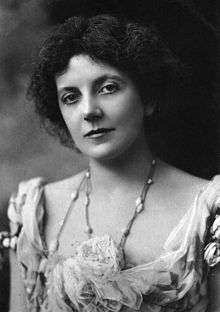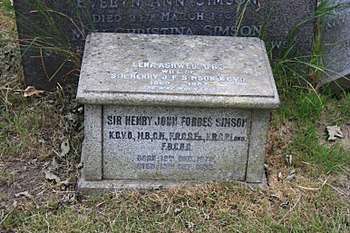Lena Ashwell
| Lena Ashwell | |
|---|---|
 | |
| Born |
Lena Margaret Pocock 28 September 1872 |
| Died | 13 March 1957 (aged 84) |
| Nationality | British |
| Occupation | Actress |
Lena Margaret Ashwell, OBE (28 September 1872 – 13 March 1957) was a British actress and theatre manager and producer, known as the first to organise large-scale entertainment for troops at the front, which she did during World War I.
Biography
She was born Lena Margaret Pocock[1] on the Wellesley while anchored in the River Tyne, at the time under her father's 'command' as a home for “boys 'unconvicted of crime' but under suspicion”. Ashwell's father was Commander Charles Ashwell Boteler Pocock, Royal Navy (March 1829–February 1899), a nephew of Nicholas Pocock, and her mother was Sarah Margaret Stevens (December 1839–May 1887), who died as a result of an accident in Canada. Lena, the second youngest of seven siblings, had two brothers and four sisters. One of her siblings died as a child while the family was in New Zealand.
She grew up in Canada, and studied music in both Lausanne and at the Royal Academy of Music in London. Her voice however was insufficient for performance and she took up acting instead, thereafter styling herself as "Lena Ashwell". In 1891, she debuted in The Pharisee, and in 1895 she appeared in King Arthur, by J. Comyns Carr, with Dame Ellen Terry and Sir Henry Irving. She went on to appear in a number of Shakespeare productions, in Quo Vadis (1900), and as the lead in Mrs Dane's Defence (1900) and Leah Kleschna (1905).
In 1906, Ashwell starred in The Shulamite, a melodrama about a South African woman in an unhappy marriage who falls in love with a visiting Englishman.[2] The show ran for 45 performances at the Savoy Theatre between 12 May and 26 June 1906.[3]
Ashwell took the play to the USA, where it ran for just 25 performances at the Lyric Theatre on Broadway. The New York Times critic wrote that Ashwell "had been rather badly handicapped on her first visit here by a bad play."[4]

Beginning in 1906, Ashwell took up theatre management, initially at the Savoy Theatre, then in 1907 she established her own theatre known as the Kingsway.
During the First World War she was an enthusiastic supporter of British war aims. Partly due to the influence of her acquaintance Princess Helena Victoria, and her connections to the YWCA, she was given permission to take a group of entertainers to the western front.[5] In 1915, she began to organise companies of actors, singers and entertainers to travel to France and perform; by the end of the war there were 25 of them, travelling in small groups around France.
She organised all-male concert parties to perform shows near to the front line. In her writings about this experience she emphasised that ordinary soldiers had been enthusiastic about high culture – in particular, Shakespeare plays.[6]
In her last years, she embraced the Moral Re-Armament movement.[7]
Her ashes are buried with her husband in Dean Cemetery in Edinburgh. The grave lies in the Victorian north extension on a north-south path north of the main path close to Else Maud Inglis.
Family
She married actor Arthur Playfair in 1896; he began divorce proceedings in 1903 following her adultery with Robert Taber, the former husband of actress Julia Marlowe. Playfair and Ashwell finally divorced in 1908.[8]
She married the royal obstetrician Sir Henry John Forbes Simson in 1908, who had the claim to fame of delivering both the future Queen Elizabeth II and her sister Princess Margaret.[9] She probably met him through her own links to the Royal family such as Helena Victoria.
Writing
Ashwell wrote four books:[7]
- Modern Troubadours (London, Gyldendal, 1922), which is an account of the work of her Concert parties during the First World War
- Reflections from Shakespeare (London, Hutchinson & Co., 1926), edited from a series of lectures she gave to raise money for the Lena Ashwell Players
- The Stage (London, Geoffrey Bles, 1929), her thoughts on the state of the theatre and role of the actor
- An autobiography, Myself A Player (London, Michael Joseph, 1936)[10]
Notes
- ↑ https://www.npg.org.uk/collections/search/portrait/mw52981/Lena-Ashwell-ne-Lena-Margaret-Pocock-later-Lady-Simson
- ↑ Leask, Margaret (1 July 2012). Lena Ashwell: Actress, Patriot, Pioneer. Univ of Hertfordshire Press. p. 111ff. ISBN 978-1-907396-75-5.
- ↑ Wearing, J. P. (5 December 2013). The London Stage 1900-1909: A Calendar of Productions, Performers, and Personnel. Scarecrow Press. p. 295. ISBN 978-0-8108-9294-1.
- ↑ Nissen, Axel (21 February 2012). Mothers, Mammies and Old Maids: Twenty-Five Character Actresses of Golden Age Hollywood. McFarland. p. 149. ISBN 978-0-7864-9045-5.
- ↑ Telegraph (newspaper) 10 June 2018, article by Kate adie
- ↑ Adie, Kate (11 April 2014). "Lena Ashwell: the woman who brought music to WW1 trenches". The Telegraph. Retrieved 18 September 2015.
- 1 2 Leask, Margaret, Doctoral thesis on the life and work of Lena Ashwell, University of Sydney (2000)
- ↑ "Arthur Playfair Seeks Divorce; Actor Involves Robert Taber, Former Husband of Julia Marlowe". The New York Times. 13 September 1903.
- ↑ http://munksroll.rcplondon.ac.uk/Biography/Details/4073
- ↑ Lena Ashwell (1936). Myself a Player. London: Michael Joseph Ltd. OCLC 614472751.
References
- Lena Ashwell (1936). Myself a Player. London: Michael Joseph Ltd. OCLC 614472751.
- Maggie Barbara Gale and Vivien Gardner, Auto/biography and Identity: Women, Theatre and Performance, Manchester University Press, 2004; ISBN 0-7190-6332-9, pp. 99–124 Lena Ashwell and Auto/biographical negotiations of the Professional Self
- Margaret Leask (1 July 2012). Lena Ashwell: Actress, Patriot, Pioneer. Univ of Hertfordshire Press. ISBN 978-1-907396-75-5.


External links
| Wikimedia Commons has media related to Lena Ashwell. |